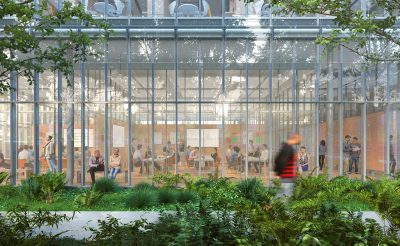Our construction cam is live! Check our our progress here.
The SNF Agora Institute draws its name from the ancient Athenian agora, a central space in the city that was a place of open conversation and debate for all citizens. Designed by world renowned architecture firm Renzo Piano Building Workshop (RPBW), our new building on Johns Hopkins University’s Homewood campus will pay homage to the ancient Athenian agora by creating a space for civic engagement and informed, inclusive dialogue in the modern era.
In September 2019, we unveiled early plans for the forthcoming building. The second set of design plans and renderings were revealed to the Hopkins community and to the public in December 2020. The building will be located directly next to the Wyman Park Building on the Homewood campus and will serve as a portal for the community to connect with us.

Renzo Piano Building Workshop and Ayers Saint Gross
Piano designed the building to be a portrait of the institute, telling the story of our work and serving as a portal for the community to connect with us. The design draws from principles of openness, accessibility, and harmony with nature. Two “floating” glass cubes will create transparency between the inside of the building and the broader world outside. One side of the building will support our scholarly work, housing faculty offices, labs, classrooms, meeting and seminar rooms, and co-working spaces. The other will be a gathering place with several agora-like spaces for conferences, speaker presentations, art exhibitions, and other events. Specifically, the building will include:
- Private offices for faculty
- Shared offices for visiting fellows
- Open workspace for staff and research teams
- Small and large labs for collaboration
- Small, medium, and large meetings rooms
- Classrooms
- A large community convening space for conferences, events, and meetings
- Community breakout rooms
- Amenities for gatherings such as a café, outdoor seating, large kitchen/dining area for faculty/staff, comfortable soft seating areas and lounges

Renzo Piano Building Workshop and Ayers Saint Gross
The new building, which will be LEED certified and landscaped to reflect the natural environment of the mid-Atlantic region, promises to be an iconic structure for Johns Hopkins and for Baltimore.

